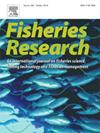Impacts of artisanal fishing on elasmobranchs along the Brazilian Amazon Coast
IF 2.2
2区 农林科学
Q2 FISHERIES
引用次数: 0
Abstract
This study aimed to identify the most commonly used artisanal fishing gear for capturing elasmobranchs along the coast of Maranhão State, within the Brazilian Amazon Coast. Interviews were conducted with 314 fishers across 17 coastal municipalities using semi-structured questionnaires. These gathered information on vessel characteristics, fishing gear, and elasmobranch species caught in the region. Six types of fishing gear were identified, with gillnets and longlines being the most frequently used. Of the 70 elasmobranch species identified along the Brazilian Amazon Coast, 35 are commonly captured. Among rays, the species most frequently cited by fishers were Hypanus guttatus, Rhinoptera bonasus, Hypanus geijskesi, Aetobatus narinari, Gymnura micrura, Mobula hypostoma, Mobula birostris, and Pseudobatos percellens. For sharks, the most frequently mentioned species included Carcharhinus acronotus, Sphyrna tudes, Carcharhinus leucas, Ginglymostoma cirratum, Galeocerdo cuvier, Rhizoprionodon porosus, and Carcharhinus porosus. Notably, all identified species are susceptible to capture by both gillnets and longlines. To mitigate the impact of these practices on population stocks, particularly for species threatened with extinction, it is essential to develop targeted conservation measures and management plans that address fishing gear, capture areas, and most vulnerable species.
手工捕鱼对巴西亚马逊河沿岸蓝鳍亚科的影响
这项研究的目的是确定在巴西亚马逊海岸内的maranh州海岸捕获蓝鳃亚目鱼最常用的手工渔具。采用半结构化问卷对17个沿海城市的314名渔民进行了访谈。这些研究收集了该地区的船只特征、渔具和板鳃纲物种的信息。确定了六种渔具,其中最常用的是刺网和延绳钓。在巴西亚马逊河沿岸发现的70种板鳃纲物种中,有35种经常被捕获。在鳐类中,最常被渔民引用的种类是黄尾鲷、白鼻翅、黄尾鲷、红尾鲷、微尾鲷、下颚鲷、小纹鲷和细纹鲷。对于鲨鱼,最常提到的物种包括Carcharhinus acronotus、Sphyrna tudes、Carcharhinus leucas、Ginglymostoma cirratum、Galeocerdo cuvier、Rhizoprionodon porosus和Carcharhinus porosus。值得注意的是,所有已查明的物种都容易被刺网和延绳钓捕获。为了减轻这些做法对种群资源的影响,特别是对濒临灭绝的物种的影响,必须制定针对渔具、捕捞区和最脆弱物种的有针对性的保护措施和管理计划。
本文章由计算机程序翻译,如有差异,请以英文原文为准。
求助全文
约1分钟内获得全文
求助全文
来源期刊

Fisheries Research
农林科学-渔业
CiteScore
4.50
自引率
16.70%
发文量
294
审稿时长
15 weeks
期刊介绍:
This journal provides an international forum for the publication of papers in the areas of fisheries science, fishing technology, fisheries management and relevant socio-economics. The scope covers fisheries in salt, brackish and freshwater systems, and all aspects of associated ecology, environmental aspects of fisheries, and economics. Both theoretical and practical papers are acceptable, including laboratory and field experimental studies relevant to fisheries. Papers on the conservation of exploitable living resources are welcome. Review and Viewpoint articles are also published. As the specified areas inevitably impinge on and interrelate with each other, the approach of the journal is multidisciplinary, and authors are encouraged to emphasise the relevance of their own work to that of other disciplines. The journal is intended for fisheries scientists, biological oceanographers, gear technologists, economists, managers, administrators, policy makers and legislators.
 求助内容:
求助内容: 应助结果提醒方式:
应助结果提醒方式:


